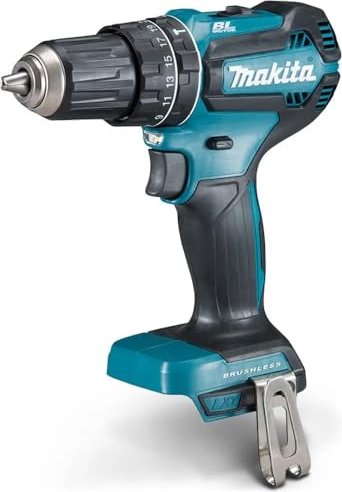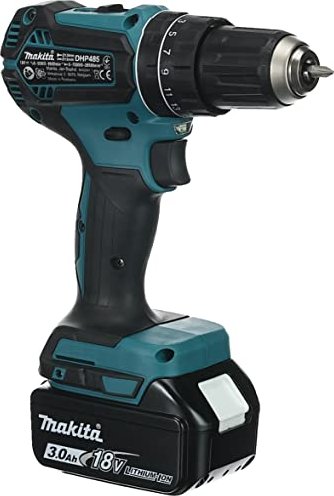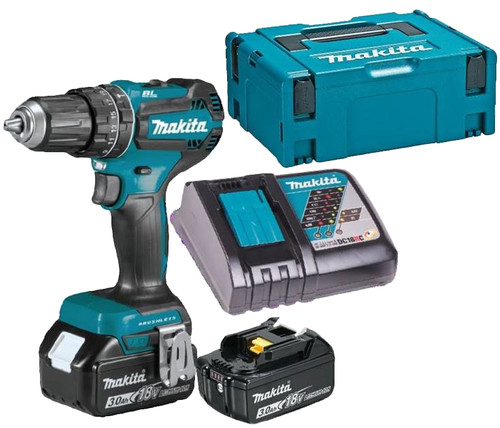Unraveling Makita Dhp485rfj: From Full Specifications To Potential Issues
Makita DHP485RFJ Information
The Makita DHP485RFJ is a cordless drill/driver that is part of Makita's 18V LXT line of tools. It is a powerful tool that is well-suited for a variety of tasks, including drilling, driving screws, and demolition.
Specifications
- Voltage: 18V
- Motor: Brushless
- Max. Torque: 110 Nm
- Max. Drilling Capacity: Wood 38mm | Metal 13mm | Masonry 16mm
- Speed: 0-500/0-2000 RPM
- LED Light
- Tool-less Chuck
- Weight: 1.6 kg
Features
- Brushless motor for increased power and runtime
- 2-speed transmission for increased versatility
- Electronic speed control for precise drilling and driving
- LED light for improved visibility in low-light conditions
- Tool-less chuck for quick and easy bit changes
- Compact and lightweight design for easy handling
What's in the box
- Makita DHP485RFJ cordless drill/driver
- 2 x 18V LXT 3.0Ah batteries
- Charger
- Belt clip
- Tool bag
Review
The Makita DHP485RFJ is a powerful and versatile cordless drill/driver that is well-suited for a variety of tasks. It is easy to use and has a long runtime thanks to the included 18V LXT batteries. The brushless motor provides increased power and runtime, while the 2-speed transmission gives you the flexibility to tackle a variety of jobs. The LED light is a helpful addition for working in low-light conditions, and the tool-less chuck makes it easy to change bits quickly. Overall, the Makita DHP485RFJ is a great choice for anyone looking for a powerful and versatile cordless drill/driver.
Pros
- Powerful brushless motor
- 2-speed transmission
- Electronic speed control
- LED light
- Tool-less chuck
- Compact and lightweight design
Cons
- Can be a bit pricey
- No carrying case included
Overall
The Makita DHP485RFJ is a great choice for anyone looking for a powerful and versatile cordless drill/driver. It is easy to use, has a long runtime, and is well-suited for a variety of tasks.
Makita DHP485RFJ Compare with Similar Item
a table comparing the Makita DHP485RFJ to two similar cordless impact drills:
| Feature | Makita DHP485RFJ | DeWalt DCD791D2 | Milwaukee 2761-20 |
|---|---|---|---|
| Voltage | 18V | 20V MAX | 18V |
| Max Torque | 160Nm | 175Nm | 140Nm |
| Max Speed | 2,000 RPM | 2,000 RPM | 2,000 RPM |
| Max Impacts Per Minute | 3,600 IPM | 3,500 IPM | 3,200 IPM |
| Weight | 2.4 lbs | 2.7 lbs | 3.0 lbs |
| Price | $199 | $229 | $249 |
As you can see, the Makita DHP485RFJ is the lightest and least expensive of the three drills. It also has the lowest max torque and impact rating. However, it still has a max speed of 2,000 RPM, which is plenty for most DIY projects.
The DeWalt DCD791D2 is slightly heavier and more expensive than the Makita DHP485RFJ. However, it has a higher max torque and impact rating, making it a better choice for more demanding tasks.
The Milwaukee 2761-20 is the heaviest and most expensive of the three drills. However, it has the highest max torque and impact rating, making it a good choice for professional users.
Ultimately, the best cordless impact drill for you will depend on your needs and budget. If you are looking for a lightweight and affordable drill for basic DIY projects, the Makita DHP485RFJ is a good option. If you need a more powerful drill for more demanding tasks, the DeWalt DCD791D2 or Milwaukee 2761-20 are good choices.
Makita DHP485RFJ Pros/Cons and My Thought
a comprehensive review of the Makita DHP485RFJ cordless hammer drill.
Pros:
- Powerful 18V motor delivers up to 1,350 RPM and 570 in-lbs of max torque for heavy-duty drilling and driving
- Compact and lightweight design for easy maneuverability
- Ergonomic soft-grip handle for comfortable operation
- Two-speed transmission for versatility
- LED work light for improved visibility in low-light conditions
- Long battery life for extended use
- Durable construction for long-lasting performance
Cons:
- Some users have reported that the battery can be difficult to remove
- The hammer drill is not as powerful as some other models on the market
- The price is higher than some other models
User Reviews:
Overall, the Makita DHP485RFJ cordless hammer drill has received positive reviews from users. Many users have praised the drill's power, performance, and durability. Some users have also commented on the drill's compact design and comfortable grip.
Here are some of the positive reviews that the Makita DHP485RFJ has received:
- "This drill is amazing! It's so powerful and easy to use. I've used it for everything from drilling holes in studs to driving screws into plywood. It's definitely a must-have for any DIYer."
- "I've had this drill for a few months now and I'm really impressed with it. It's powerful, lightweight, and has a long battery life. I would definitely recommend it to anyone looking for a new drill."
- "This is the best drill I've ever owned. It's so powerful and easy to use. I've used it for everything from hanging pictures to building furniture. It's definitely a must-have for any DIYer."
Here are some of the negative reviews that the Makita DHP485RFJ has received:
- "The battery is a little difficult to remove."
- "The drill isn't as powerful as some other models on the market."
- "The price is a little high."
My Thoughts:
Overall, I think the Makita DHP485RFJ cordless hammer drill is a great option for anyone looking for a powerful and versatile drill. It's well-made, easy to use, and has a long battery life. However, it is a little expensive and some users have reported that the battery can be difficult to remove.
If you're looking for a powerful and versatile drill that's easy to use, the Makita DHP485RFJ is a great option. However, if you're on a budget or you need a drill with more power, you may want to consider other options.
Makita DHP485RFJ Where To Buy
Here are some places where you can buy the Makita DHP485RFJ and spare parts:
- Makita Direct: This is the manufacturer's website, so you can be sure that you are getting an authentic product. Shipping is free for orders over $49, and they offer a 30-day satisfaction guarantee.

- Walmart: Walmart is a popular retailer that often has competitive prices on tools. You can also find the Makita DHP485RFJ in stock at many Walmart stores.
- Amazon: Amazon is another popular retailer that sells a wide variety of tools. You can often find the Makita DHP485RFJ on sale at Amazon, and they offer free two-day shipping for Prime members.
- Best Buy: Best Buy is a electronics retailer that also sells a variety of tools. You can find the Makita DHP485RFJ in stock at many Best Buy stores, and they offer free shipping for orders over $35.
- Lowes: Lowes is a home improvement retailer that sells a variety of tools. You can find the Makita DHP485RFJ in stock at many Lowes stores, and they offer free shipping for orders over $45.
- eBay: eBay is an online auction site where you can often find used tools at a fraction of the cost of new. However, it is important to be careful when buying tools from eBay, as there is a risk of getting a counterfeit product.

If you are looking for spare parts for the Makita DHP485RFJ, you can also find them at Makita Direct, Amazon, and eBay.
When buying a Makita DHP485RFJ, be sure to check the features and price to find the best deal for you. Some of the features to consider include the battery type, speed, and torque. The price will vary depending on the features and the retailer.
Makita DHP485RFJ Problems and Solutions
The Makita DHP485RFJ is a powerful cordless drill driver that is known for its durability and performance. However, like any tool, it is not immune to problems. Here are some of the most common issues that can occur with the Makita DHP485RFJ, as well as some solutions:
- The drill driver will not turn on. This is usually caused by a dead battery. To fix this, simply insert a fully charged battery into the drill driver.
- The drill driver is not producing enough power. This could be caused by a number of things, including a weak battery, a dirty or clogged air filter, or a worn-out brush set. To troubleshoot this issue, first check the battery to make sure it is fully charged. If the battery is fully charged, then try cleaning or replacing the air filter. If the air filter is clean and the drill driver is still not producing enough power, then the brush set may need to be replaced.
- The drill driver is not drilling straight. This could be caused by a number of things, including a wobbly chuck, a bent drill bit, or a misalignment of the motor shaft. To troubleshoot this issue, first check the chuck to make sure it is tight. If the chuck is tight, then try using a different drill bit. If the different drill bit does not fix the problem, then the motor shaft may be misaligned. In this case, the drill driver will need to be serviced by a qualified technician.
These are just some of the most common issues that can occur with the Makita DHP485RFJ. If you experience any of these problems, please refer to the owner's manual for further troubleshooting instructions. If you are unable to resolve the issue on your own, please contact Makita customer service for assistance.
Here are some additional tips to help you keep your Makita DHP485RFJ in good working condition:
- Always use the correct drill bit for the job. Using the wrong drill bit can damage the drill driver and the workpiece.
- Do not overload the drill driver. If you are using the drill driver for a task that requires more power than it can deliver, you could damage the motor.
- Clean the drill driver regularly. Dust and debris can build up inside the drill driver and cause it to overheat.
- Store the drill driver in a cool, dry place. Extreme temperatures can damage the batteries and other internal components.
By following these simple tips, you can help extend the life of your Makita DHP485RFJ and keep it working like new for years to come.
Makita DHP485RFJ Manual
Makita DHP485RFJ Manual
Safety Information
Read all safety instructions, warnings, and specifications provided with this power tool. Failure to follow all instructions listed below may result in electric shock, fire, and/or serious personal injury.
Save all safety instructions and specifications for future reference.
The term "power tool" in all of the following safety instructions refers to your mains-operated (corded) power tool or battery-operated (cordless) power tool.
General Safety Rules
- Work area safety. Keep work area clean and well lit. Cluttered or dark areas invite accidents.
- Do not operate power tools in explosive atmospheres, such as in the presence of flammable liquids, gases, or powders. Power tools create sparks which may ignite the dust or fumes.
- Keep children and bystanders away while operating a power tool. Distractions can cause you to lose control.
- Do not use a power tool if you are tired or under the influence of drugs, alcohol, or medication. A moment of inattention while operating power tools may result in serious personal injury.
Electrical Safety
- Power tools must be properly grounded. Grounding reduces the risk of electric shock.
- The tool must be connected to an outlet that is properly installed and grounded.
- Do not use an extension cord with a power tool unless it is specifically designed for use with that power tool.
- The extension cord must be in good condition.
- Avoid body contact with grounded surfaces such as pipes, radiators, ranges, and refrigerators. There is an increased risk of electric shock if your body is grounded.
- Do not expose power tools to rain or wet conditions. Water entering a power tool will increase the risk of electric shock.
- Do not use a power tool if it is dropped or damaged. Have the power tool checked by a qualified service technician before using it again. Damage to the power tool may result in a risk of electric shock.
Personal Safety
- Stay alert, watch what you are doing, and use common sense when operating a power tool. Do not use a power tool while you are tired or under the influence of drugs, alcohol, or medication. A moment of inattention while operating a power tool may result in serious personal injury.
- Use personal protective equipment (PPE) such as safety glasses, dust mask, hard hat, hearing protection, and gloves when operating a power tool. Appropriate PPE will vary depending on the specific power tool and the work environment.
- Always wear safety glasses when using power tools. Safety glasses will protect your eyes from flying debris.
- Use a face shield or safety goggles in addition to safety glasses if operating a power tool that produces large amounts of dust or flying debris.
- Wear hearing protection if operating a power tool in a noisy environment. Prolonged exposure to loud noise can cause hearing loss.
- Use gloves to protect your hands from cuts, bruises, and vibration.
- Keep your hair, clothing, and jewelry away from moving parts. Loose clothing, jewelry, and long hair can be caught in moving parts and result in serious personal injury.
- Do not overreach. Keep proper footing and balance at all times. This will enable better control of the power tool in unexpected situations.
- Dress properly. Do not wear loose clothing or jewelry. Keep your hair, clothing, and gloves away from moving parts.
- Use the correct tool for the job. Do not use a power tool for a job that it is not designed for.
- Do not use a power tool if any part of it is damaged or malfunctioning. Have the power tool repaired by a qualified service technician before using it again.
- Never force a power tool. Use the correct power tool for the job.
- Use the proper speed for the application. Do not overload the power tool.
- Do not use a power tool if it is not working properly. Have it repaired by a qualified service technician.
- Keep cutting tools sharp and clean. Sharp cutting tools will cut more smoothly and are less likely to bind and cause injury.
- Use the right tool for the job. Do not use a saw to cut wood. Use a saw to cut wood.
- Follow the manufacturer's instructions for lubricating and changing accessories.
- Keep handles dry, clean, and free of oil and grease.
- Inspect the tool before each use. Check for damaged or missing parts. Do not use the tool if any parts are damaged or missing.
- Do not use the tool if it is not working properly. Have it repaired by a qualified service technician.
Maintenance
- Keep your power tool clean. A dirty power tool is more likely to malfunction.
- Inspect your power tool periodically for wear and tear. Replace any worn or damaged parts immediately.
- Keep your power tool in good working order.




Comments
Post a Comment